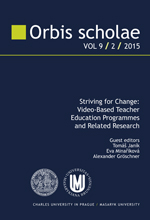Case-Based Learning in Initial Teacher Education: Assessing the Benefits and Challenges of Working with Student Videos and Other Teachers’ Videos
Case-Based Learning in Initial Teacher Education: Assessing the Benefits and Challenges of Working with Student Videos and Other Teachers’ Videos
Author(s): Kathrin Krammer, Isabelle Hugener, Manuela Frommelt, Gabriela Fürrer Auf der Maur, Sandro BiaggiSubject(s): Social Sciences
Published by: Univerzita Karlova v Praze, Nakladatelství Karolinum
Keywords: teacher education; professional vision; case-based learning; lesson analysis; different types of classroom videos
Summary/Abstract: The ability to analyze classroom situations proficiently is regarded as one of the key prerequisites for successful teaching. Although a steadily increasing body of empirical evidence proves that case-based learning with videos can foster professional vision in teachers, it is still necessary to gain a better understanding as to what type of video (one’s own or those of other teachers) is especially impactful in initial teacher education. Against this background, we conducted the intervention study VideA (“Video Analysis in Teacher Education”) in the first year of a Swiss teacher preparation program, whose chief aim consisted in promoting pre-service teachers’ professional vision. Concretely speaking, we compared the students’ (N = 159) and their facilitators’ (N = 26) assessments of case-based learning with their own and other teachers’ videos in terms of self-reported acceptance and effectiveness. Three seminar groups of about 18 second-semester students analyzed videos of their own teaching (Intervention A; n = 56), while three other seminar groups of about the same size analyzed videos of other teachers unknown to them (Intervention B; n = 51). The analyses were moderated by facilitators and supported with supplementary materials originating from the videotaped lessons. Acting as a control group, students in a further three seminar groups solely analyzed written teaching and learning materials, and did not make use of videos altogether (n = 52). The results show that the students’ as well as the facilitators’ ratings are quite high, irrespective of the examples of actual teaching practice used. Yet a comparison of the two video settings revealed that learning with one’s own videos received a higher degree of acceptance from both the students and the facilitators than working with other teachers’ videos. The same applies to effectiveness, which got slightly higher ratings in Intervention A than in Intervention B.
Journal: Orbis scholae
- Issue Year: 9/2015
- Issue No: 2
- Page Range: 119-137
- Page Count: 19
- Language: English

